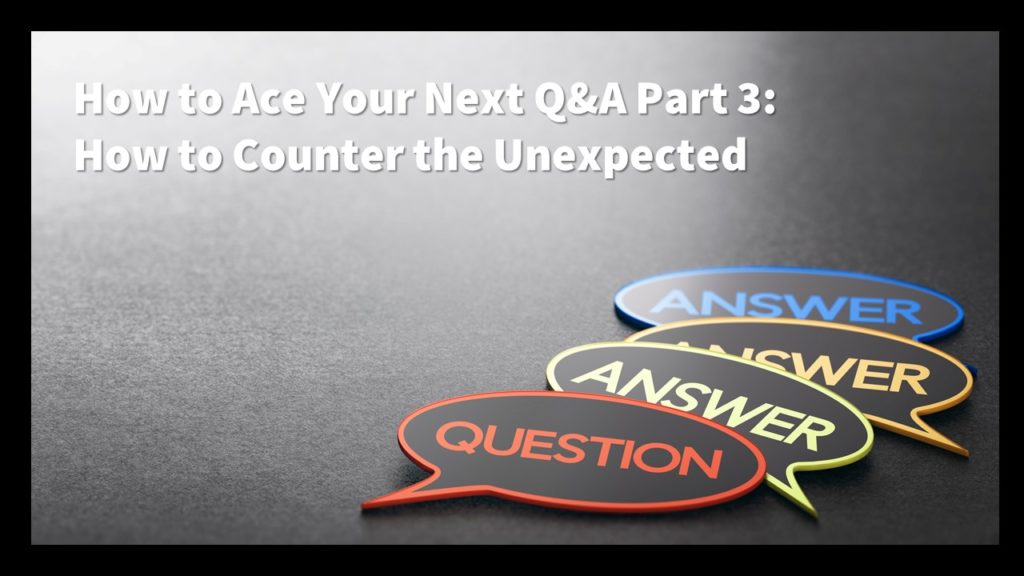How to Ace Your Next Q&A Part 3: How to Counter the Unexpected
This post is part of a four-part series that will teach you how to prepare for and conduct effective, memorable, and meaningful question-and-answer sessions.
Even the most well-prepared speakers sometimes enter their talks with the anxiety that an unexpected question will catch them off-guard and leave them looking like a proverbial deer in headlights.
The good news, however, is that you can mitigate that risk with a combination of sound preparation and knowledge of a few versatile question-answering techniques.

3 Ways to Answer Tough Questions
First, begin by making a list of questions you are likely to be asked. Then, add a few questions you don’t anticipate receiving – but that would be particularly challenging to answer if you did. Finally, develop responses to those questions using one of the three techniques that follow.
Of course, there may still be times you’re asked a question you simply couldn’t anticipate. These techniques will help you navigate those moments as well, as they offer a structure that will help you find a thoughtful and credible response quickly. You may find yourself using one, two, or all three during a single Q&A session.
The “3S” Technique
With the “3S” Technique, you provide a targeted answer to a straightforward question. After you hear the question, deliver a one- or two-sentence short opening statement. Follow with supporting evidence, such as examples, anecdotes, or statistics. Conclude with a summary statement that shines a spotlight on your most important message, point of view, or action step.
Here’s an example:
Question: “I’ve read that climate change will affect global coffee production. How will your coffee chain be affected by that?”
Short Opening Statement: “The forecasts are frightening, and if they come true, there’s no doubt that our business would be negatively affected.”
Supporting Evidence: “Some coffee-growing regions will see their production cut by as much as two-thirds from now to 2050, according to the Intergovernmental Panel on Climate Change. And, as the BBC recently noted, the ‘proportion of coffee species at risk is three times the figure for plants generally, which suggests that coffee is an especially vulnerable plant.’”
Summary Statement: “So, we’re likely to see lower supply, which means consumers will see higher costs. But all is not lost. We’re working in partnership with growers and international organizations to develop and fund innovative approaches to cultivate more heat-tolerant varieties, which will help to keep coffee mugs full for many years to come.”
The AAa Formula
When facing audience members who are upset, fearful, or angry, it’s important to offer not only an accurate response, but one that acknowledges and addresses the emotion behind it. The AAa Formula will help you pair their heated question or comment with your emotionally aligned response.
First, acknowledge their concern, struggle, or challenge. People in your audience need to feel that you “get it,” not just that you know the cold, hard facts. Sometimes, an empathetic “thank you” is enough. Other times, responses such as, “I’m truly sorry to hear that,” or “That sounds very challenging, and I’d like to try to help” set the right tone. Avoid banal reassurances such as “I completely understand” unless you have direct personal experience with the same challenge.
Then, answer with practical advice, relevant evidence, key statistics, compelling case studies, or examples. The information, however, must be linked to actions that will directly address the concerns raised.
Finally, advocate. This is not always necessary (hence the lowercase “a”), but you can use it if you are issuing a call to action.
Here’s an example:
Acknowledge: “I can’t imagine the devastation and disruption this storm has caused you. I know you want answers as to when you can get your life back, and I know I can’t give you what you really want – an exact date. What I can tell you is…”
Answer: “… that today, we’ve gathered representatives from local disaster assistance programs, insurance representatives, city officials, and nonprofit agencies to get you through an expedited application process. Rebuilding is going to take time. But, today, we’ll get you started.”
advocate: “If you haven’t already, I also urge you to take advantage of the 24-hour disaster recovery hotline we’ve set up to get you answers. There’s a real person there around the clock, ready to help you.”

Restatement Bounce
There will be times you’ll have to deal with a question where the answer seems a foregone conclusion – from the perspective of the person asking it! There’s a valid concern in there, but the question is loaded with negative language or critiques.
With the Restatement Bounce, you’ll listen carefully to the question and restate it in a manner that neutralizes the negativity but still addresses the heart of the question. Then, you’ll offer two responses: a short, declarative one and a longer one, during which you will elaborate, add context, and introduce supporting material. Don’t let the name fool you, however – the “long” answer should not exceed one minute or so.
Here’s an example:
Question: “Why doesn’t your software firm offer free technical support for previous editions of your software? That’s a heavy-handed way to force your customers to upgrade to your latest version.”
Restatement Bounce: “Why do we only provide free support for the latest edition of our software?” or “Thank you. Let’s talk about our decision to only provide free support for the latest edition of our software.”
Short Answer: “We do that because we’ve found it’s the best way to offer consumers a great product at the lowest-possible price.”
Long Answer: “We used to support older versions of our software for free — but we learned that we needed dozens of employees to handle all the inquiries from consumers about the product. We had to make a decision: provide free support to customers who were still using an outdated technology but raise the cost of the product to allow for that support, or only support the current version but make it available to customers at a lower price. We wrestled with that decision, but our research has subsequently found that 91 percent of our customers rate our pricing plans as ‘good’ or ‘excellent’ in surveys.”
Previous posts in this series:
INTRODUCTION: How to Ace Your Next Q&A


